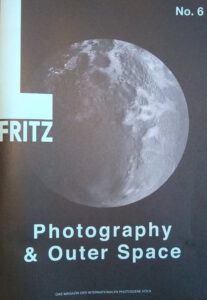@ 2020 Internationale Photoszene Köln gemeinnützige Unternehmergesellschaft (haftungsbeschränkt), die Fotografen und Autoren [und Übersetzer] Earthrise
The story of a photograph that changed awareness of our planet began on a roof in San Francisco – and 100 micrograms of LSD
By Damian Zimmermann
February 1966. Stewart Brand, 28 years old at the time, was sitting on the gravel roof of his apartment block in San Francisco, high on a recently popped LSD trip and contemplating the skyline. Suddenly, he noticed that high-rises do not climb into the sky parallel to one another. Viewed strictly in terms of physics, what sounds like a serious hallucination is correct: the natural curvature of the Earth’s surface produces the effect that the tops of buildings, the higher they are, are ever further removed from one another. But Brand’s train of thought had not yet arrived at its terminus, here: sitting on the block’s third storey and floating on 100 micrograms of acid, he suddenly saw and felt the Earth’s curvature in front of and especially beneath him in total clarity and soared further and further away from his actual location in North Beach into orbit, from where he beheld the Earth in its entirety – an image that must have been fully a fruit of his imagination, for there was not yet any photograph of Earth from outer space in existence in early 1966.
While Brand, who had graduated in biology from Stanford in 1960 and subsequently been in the army, was on his imaginary orbit, he obligatorily thought of the architect, designer and visionary Richard Buckminster Fuller. Shortly before, during a lecture in Santa Fe, the latter had noted that humanity was behaving as though the Earth were an infinitely large disc, and we would never get things right with our civilization as long as we did not treat the Earth as what it actually is: finite. Earthrise
[…]
Gripped by this idea, Brand considered how he could persuade NASA or the Russians to take a photo of that kind – and decided to produce posters and, in particular, hundreds of small button badges, which he intended to sell at uni for 25 cents apiece. But what were those badges going to say? He quickly rejected the first idea, which involved the appeal to “Take a photo of the whole Earth!” No, it was too boring and square. The badge should throw up a question and simultaneously quicken American paranoia: “Why haven’t we seen a photograph of the whole Earth yet?” Bingo!
Next day, Brand printed the button badges, pulled on a white jumpsuit and a top hat bearing a glass heart, and positioned himself with a neon-coloured sandwich board on the University of California campus in Berkeley, on the other side of San Francisco Bay. The plan worked: the buttons got sold and the faculty director threw him off the grounds, whereupon first the “San Francisco Chronicle” and, finally, other newspapers too reported on Brand’s story. That was how self-marketing was done in the 1960s. Earthrise
From that point on, Brand sold the button badges at other elite universities such as Stanford, Columbia, Harvard and the Massachusetts Institute of Technology (MIT). He sent them to scientists, senators, to Russia and to United Nations officials, but also to the big thinkers of that period, foremost of all the philosopher and communication theorist Marshall McLuhan and, naturally, Richard Buckminster Fuller.
It is hard to say how far Brand’s actions actually influenced the astronautics agency. After all, the aim of the NASA programme, costing billions of dollars, was to conquer the Moon and not to photograph the Earth.
[…] […]
[At any rate,] it took [another year and, above all,] three somewhat homesick, melancholic astronauts in a little spaceship called Apollo 8 to change this. After their third orbit of the Moon on Christmas Eve 1968, on-board engineer and photographer William Anders suddenly spotted the Earth emerging from behind the Moon’s horizon and was absolutely beside himself: “Oh, my God! Look at that picture over there! Here’s the Earth coming up. Wow, is that pretty!”
[…]
[And] with “Earthrise” he created not only one of the greatest photographic icons of the 20th century, but solved with his image exactly what Brand had demanded just two years before: a picture that gives humanity pause. That makes our planet’s finitude and vulnerability, but also incredible beauty and uniqueness universally comprehensible. And that generates an awareness that we need to protect this place we call ours.
The attention that “Earthrise” received was gigantic. The photo appeared in numerous newspapers and on the front cover of the “New York Times”; in 1969, the American post office even printed a 6-cent stamp bearing the motif. The photo become one of the most important symbols and, above all, a positive emblem of the burgeoning ecology movement. The popular CBS newscaster Walter Cronkite not only had “Earthrise” in a frame on his desk, but was also inspired by it to make a regular feature on the evening news: topics such as ecology and overpopulation were treated in detail and for the masses under the dramatic title “Can the World Be Saved?” What is more, Cronkite’s broadcast generated enormous attention for the first “Earth Day” in 1970.
Basically, therefore, everything transpired exactly the way Stewart Brand had yearned for on his orbiting LSD trip. Incidentally, he contributed not only to the creation, but also dissemination of this and similar photos: the front page of his counterculture magazine “Whole Earth Catalog”, founded in 1968, always featured a photograph of the Earth. “Earthrise” itself landed on it not once, but twice.
[…]
[Apropos:] Fuller [indeed] replied to the letter sent to him by the then unknown 28-year-old Brand during the button badge campaign – and supplied the laconic, but also singularly correct answer to his question why we still had not seen a photograph of the whole Earth: “Well, you can only see about half the Earth at any given time.”![]() Earthrise
Earthrise
